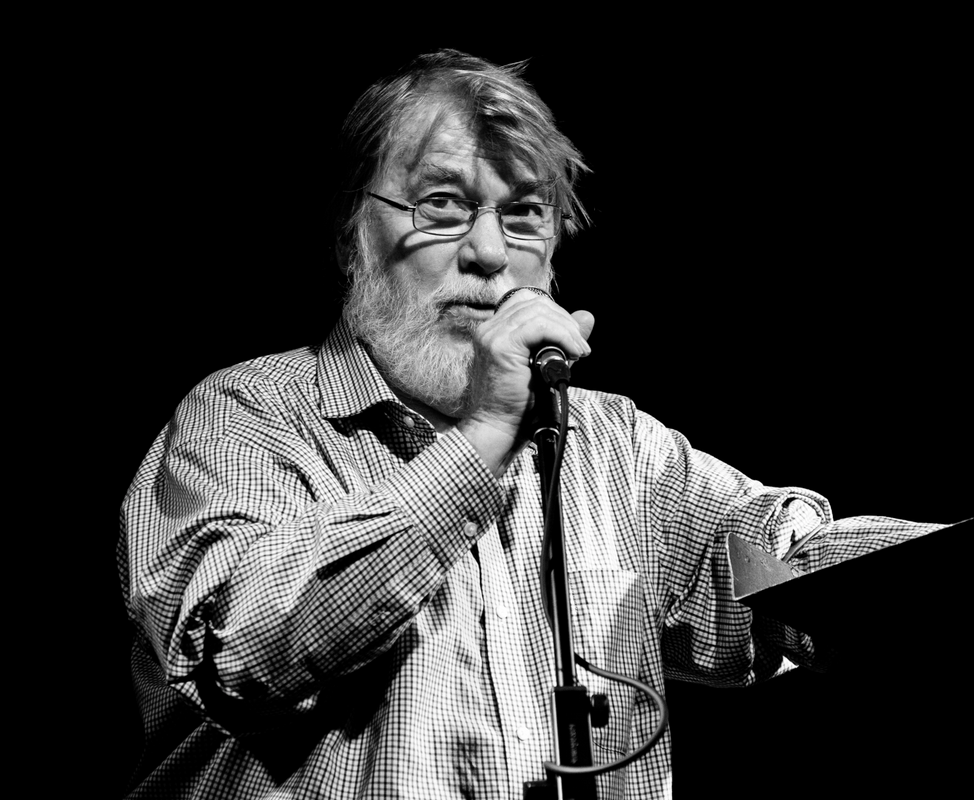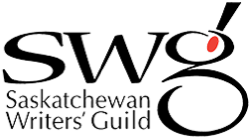Mari-Lou Rowley – You’re bio is pretty impressive. Just to recap, as a multidisciplinary artist your work includes poetry, fiction, performance poetry, visual poetry, free-improv soundsinging, and harmonica—and you’ve performed in Canada, Europe, US, and South America.
Paul Dutton – Yes, but I’m very fussy about terms. I reject “multidisciplinary artist” because it smacks too much of the academic cooption of the arts. I prefer multi-arts or interarts artist.
ML – OK. My next question is where did you start, or what form captivated you at first?
PD – From the time I was able to read I always wanted to be a writer. I didn’t really know what that meant, but it started with learning to read. I was reading Great Expectations at the age of about 8, and then went downhill to the Hardy Boys. I tried writing stories, but I was no good at it. I could come up with a description of the brothers and their chubby friend Chet, but then just stalled. I’ve never been a plot person.
In my teens, I thought I wanted to be a journalist but became disillusioned with that in university, when I realized that poetry was calling me, that I had a vocation to poetry. And I really believe that an artist is someone who has a vocation. I’m suspicious of people who “do art” for a while and then become an entrepreneur or something and quit any creative activity.
ML – Right. It’s not a job.
PD – Yeah. But I didn’t realize that you had to have a job to do it, at least for a time, or unless you’re very lucky. Anyway, it started in high school with English Composition, a subject I excelled in. That’s when I really got bit by the writing bug. In university, my focus shifted to poetry.
My main inspiration started with Dylan Thomas, E. E. Cummings, and William Butler Yeats. Then it took a quantum leap forward when I met bpNichol, who was about the same age as me but far more advanced as a person and an artist. I learned from him the difference between using the language for your own personal purposes and using the language to learn from, following where the poem wanted to go instead of forcing it to say what you wanted to say. Barrie also introduced me to visual and sound poetry.
ML – How much was your work inspired by Dadaism and Oulipo?
PD – Not at all by Oulipo, really. I read some of the writers, but that was much later on. Raymond Queneau was the main one. The first time someone mentioned Oulipo to me, I didn’t know what they were talking about.
On the other hand, I was very much influenced by Dada, which I came to very much through Nichol. Barrie introduced me to people like Kurt Schwitters and Hugo Ball, and to Caberet Voltaire. The Dadaists were a major influence on The Four Horsemen as a group, so I absorbed a lot of it through that. Steve McCaffery and Nichol were the ones who were well-versed in the history and works of the Dadaists. I followed up with my own research and reading.
ML – We first met in Toronto in the ’80s when you were part of The Four Horsemen. That’s the first time I heard collaborative performance poetry. I was pretty blown away with the power, resonance, and humour. Tell me a bit about how that group started.
PD – It started when Rafael Barreto-Rivera attended a performance by bp and Steve and was just knocked out by it. He didn’t know Steve but he did know bp slightly, enough to send him a note saying that he would like to get together with Barrie and Steve and “jam.” Barrie had tired of solo sound work and was interested in collaboration, so when he got the note from Rafael, knowing that I was getting into sound poetry, he immediately called me, very excited about the possibility of a sound-poetry quartet and wanting to know if I was interested. I certainly was.
ML – You published the visual poetry chapbook The Plastic Typewriter in 1991. I just dug out my copy, which has a broadside of your performance in Milwaukee, including two of your great transformative poems “Cross-Breeding,” and “Great Lakes.” You describe the work in The Plastic Typewriter as canonical. Can you talk about that? I think it was in the context of your works?
PD – It’s canonical in the fields of typewriter art and visual poetry. Excerpts are included in Barrie Tullett’s landmark anthology Typewriter Art: A Modern Anthology and the whole of it is archived in the visual poetry section of Ubuweb. Eric Schmaltz’s MITSUMI ELEC. CO. LTD.: keyboard poems is basically a response to it. And it is of course canonical within my own oeuvre. Let me say some more about that.
Before I met bp, I had had a few poems published in litmags, as we called them in those days. But once Beep’s major artistic influence and personal friendship came into my life, from that point on the whole of my arts practice became focused on incorporating the concept of “borderblur,” a term coined by British typewriter artist and visual poet Dom Sylvester Houédard (or just dsh, as he signed his works). My whole practice revolved around the conviction that poetry and writing could incorporate visual and sound elements, which I still like to refer to as arising from an expanded view of language. But of course those are elements of language anyway. The sonic and visual components of language are inherent at a certain point in history. First, from day one, the sonic in everyday speech, and the visual once writing came into play.
So my work and the work of many of my colleagues and peers in those areas just amplified those elements, while not abandoning the more conventional forms of literary expression, however unconventionally practised. At the same time, there are plenty of poets who work exclusively within the spheres of sound poetry and/or visual poetry.
ML – This nicely segues into my next question. You wanted to discuss contemporary visual poetry (vizpo) and some of its Canadian and British practitioners.
PD – I’m no expert by any means. There’s too much activity for me to keep up with—around the world, not just in Canada and Britain. But I do catch wind here and there—mostly from younger poets I’m in touch with one way or another, or by poking around on the web—of some exciting things going on. I know of three British publishers of vizpo (though it mostly gets spelt unphonetically as vispo, which I really don’t get, like mic instead of mike; I mean, no one writes showbus instead of showbiz): https://penteractpress.com, https://www.poematlas.com, and https://zimzalla.co.uk
Penteract has published works by Derek Beaulieu and Gary Barwin, two well-established Canadian writers who have made visual poetry a mainstay of their poetic practices right from the start. There is also a Swedish publisher,www.timglaset.com, who’s published Canadian poet Eric Schmaltz’s visual poetry. Some other Canadian vizpo practitioners creating work that I find impressive are Kate Siklosi, Dani Spinosa, (together they operate Gap Riot Press), and Judith Copithorne. Judith, as you may know, has been at it since the ’60s and is still going strong, having developed her craft over the years and branched out from print pieces into digital works. Another Order: Selected Works by Judith Copithorne, edited by Eric Schmaltz, is due to come out this fall from Talonbooks. Her work is amazing: just do a browser search on her name and click on “Images.” Stunning.
All of these poets and many others, who variously specialize exclusively in vizpo or comprise it within their broader (e.g., stanzaic, sound) poetic practices, have advanced the genre far beyond anything I ever did, creating highly sophisticated works throughout a vast range of styles, employing a wealth of media from the physical to the digital and a dizzying multiplicity of materials spanning the spectrum from eggshells to beehives, paper to textiles. And again, this is international, multilingual activity, most of which doesn’t require polyglotism to be appreciated, a brief glossary usually doing the trick. In fact, Henri Chopin, a seminal figure in the area, valued visual poetry as an international medium that goes beyond the limitations of any one linguistic population.
There’s another subgenre, video poetry, that should be mentioned. Tom Konyves, a pioneer in that field, mounted an international exhibition at the Surrey Art Gallery in the fall of ’22: https://www.youtube.com/watch?v=9PfDA0JJHVw for more on that.
ML – Who are you reading now?
PD – First of all, I would like to add to that list of vizpo creators Michael E. Casteels http://puddlesofskypress.com/index.html, whose chapbook ONDO, is a masterpiece, and a visual marvel. And it’s appropriate to mention it at this point, because it’s something I am currently reading, though it’s as much just looking at it as reading, because much of it is alphabetically abstract (what often gets called, contradictorally, concrete). It’s put out by nOIR:Z, https://www.noirzvisualpoetry.com, a Canadian publishing venture of bill bissett (where have I heard that name before?), Hart Broudy, and Brian Dedora.
I’m catching up on the classics, having recently read Moby-Dick (thumbs up) and Charlotte Brontë’s Shirley (myeh). I’m always returning to Ulysses, building up to take another crack at Finnegans Wake, and finally have embarked on Proust’s Remembrance of Things Past (which I think should be called In Search of Bygone Days). I’m immersed again in The Acacia by Claude Simon, one of my favourite late 20th-century novelists. Just finished contemporary Spanish novelist Enrique Vila-Matas’s Mac’s Problem. His work is such a joy, especially Bartleby & Co and Montano’s Maladay—a diptych, really. Brilliant originality. And I’ve been returning to Dave Donnell’s and Don Domanski’s poetry, dipping in and out.
ML – Just to end the interview on a more personal note, what are you working on now?
PD – I have completed my part of the preparation of a book of my poetry for a publication translation into Ukrainian. Just shortly after everything was in the hands of the Ukrainian publisher and after the CC had declined his application for a translation grant, and before he could get around to reapplying, just after all that, Putin, who never did like my poetry, invaded Ukraine. So now the potential audience has been decreased by the millions of killed, displaced, and emigrated individuals. As far as I can tell, the project’s dead.
ML – Have you heard from your Ukrainian publisher? How is he doing?
PD – Yeah. Yury [Zavadsky] lives in Ternopil, which is well away from the front but we know that no place is safe. His wife and children have been safely out of the country in Poland since the start of the war, and the last I heard, he was applying for a long-term residency in the States for himself with his family, and I provided a letter of recommendation for that. So I’ve got my fingers crossed.
ML – I hope he gets it.
PD – So do I.
What I’m working on now in the literary sphere are three books, the writing of which is done, and I’m getting them into shape to submit to publishers. They are a collection of prose works called Fictivities; a collection of the poetry I’ve written since 1991, to be called either Eye of the Poem, or Legeredemind; and a poetry-cum-word-game book called The Additives, which I have hopes of finding a commercial publisher for so as to reach more than a literary audience.
So, the three books as mentioned, plus ongoing concerts with CCMC, reconstituted since the death of Michael Snow, bringing back into the band some of the original members who’d strayed away for a few decades. I’m also working with a group of German and Canadian musicians who perform under the name Aurealities, inspired by and in tribute to my poetry, taking their name from my 1991 poetry book. The group gave concerts in Berlin and Cologne in 2021, https://www.matthiasmainz.com/audiovideo/aurealities, and is booked into the 2023 Festival de Musique Actuelle à Victoriaville (FIMAV), with me included in the ensemble, https://www.fimav.qc.ca/en/joe-sorbara-matthias-mainz.
ML – Wonderful! When is this?
PD – Friday evening of the Victoria Day weekend, May 19. A warm-up Toronto concert on the 17th is slated to take place at Annette Studios, a new venue right in the neighbourhood I grew up in, less than a kilometer from the house where I lived for my first 25 years. Talk about coming full circle. And talk about changes: there sure was nothing anywhere near like that in the area back in the 1950s and ’60s.
ML – Any advice to young poets (any genre)?
PD – The first thing is, learn everything you can about the language, as it’s spoken and as it’s written, all the nuances of all its aspects. Read dictionaries—of words, idioms, everything; and reference books—on grammar, style, punctuation, the works. Then make use of or take liberties with it all as artistic exigency dictates.
The second thing is, immerse yourself in the works of the masters. Never stop learning and developing. Be a perpetual apprentice—to those who went before you and those coming up after you.
One other thing: get a trade or a profession, or a spouse with a trade or profession. That’s from a practical standpoint. Try to get something related to your artistic skills and keep on the lookout for opportunities to practise your art full time.
ML – This is great, and I think this is a good note to end on. Thanks Paul!





